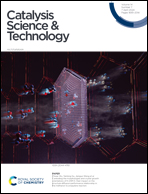Fabrication of well-structured NiMo hydrodesulfurization catalysts using electropositive Mo-based nanoparticles
Abstract
The electrical properties of the active precursor ions play an important role in the microstructure of the hydrodesulfurization (HDS) catalyst. Herein, this study first presents a simple strategy to adjust the charge of Mo-based nanoparticles (Mo-NPs) by changing the content of the organic complexing agent dodecyltrimethylammonium bromide (DTAB) and then investigates the effects of Mo-NPs with different charges on HDS catalysts. The results show that the zeta (ζ) potential of the Mo-NPs mutates from negative to positive with the DTA+/Mo molar ratio increasing to 4/7. Compared with conventional electronegative Mo precursors, the electropositive Mo-NPs could eliminate the electrostatic difference with the promoter nickel ions (Ni2+); thus, the Mo-NPs and Ni2+ could synchronously diffuse and co-load into the electropositive pore of γ-Al2O3 by hydrothermal deposition, resulting in a more uniform distribution of active species (standard deviation of slab length = 0.51 vs. 1.05). Meanwhile, the isolating effect of amorphous carbonaceous species from the thermal decomposition of the organic complexing agent on the active phases was directly observed, and the stabilizer role was powerfully verified. Therefore, the resultant catalyst not only realized better Ni-promoted effects (synergetic factor = 7.5 vs. 5.3) but also exhibited excellent active phase morphology with much shorter length, higher stacking number and better dispersion. Finally, compared with the catalyst prepared from the conventional precursor, i.e. Mo7O246−, the Mo-NPs-derived catalyst shows the more excellent HDS activity of dibenzothiophene (reaction rate constant kHDS = 7.51 vs. 1.06 × 10−7 mol g−1 s−1; turnover frequency TOF = 5.56 vs. 1.43 h−1) and obviously enhanced HDS ratio of heavy coking diesel (99.8% vs. 96.2%). Besides, the resulting catalyst also holds a much higher HDS ratio as compared with the industrial catalyst (99.8% vs. 97.8%), showing a great potential in industrial application. The present work sheds light on the rational design of supported nanosized catalysts and provides a deeper understanding of the complicated structure–function relations.



 Please wait while we load your content...
Please wait while we load your content...